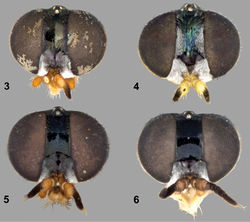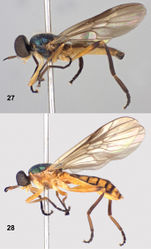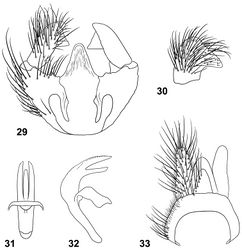Paraberismyia tzontehuitza
| Notice: | This page is derived from the original publication listed below, whose author(s) should always be credited. Further contributors may edit and improve the content of this page and, consequently, need to be credited as well (see page history). Any assessment of factual correctness requires a careful review of the original article as well as of subsequent contributions.
If you are uncertain whether your planned contribution is correct or not, we suggest that you use the associated discussion page instead of editing the page directly. This page should be cited as follows (rationale):
Citation formats to copy and paste
BibTeX: @article{Woodley2013ZooKeys353, RIS/ Endnote: TY - JOUR Wikipedia/ Citizendium: <ref name="Woodley2013ZooKeys353">{{Citation See also the citation download page at the journal. |
Ordo: Diptera
Familia: Stratiomyidae
Genus: Paraberismyia
Name
Paraberismyia tzontehuitza Woodley, 1995 – Wikispecies link – Pensoft Profile
- Paraberismyia tzontehuitza Woodley, 1995: 136.
Diagnosis
Paraberismyia tzontehuitza can be distinguished from other species in the genus by having the combination of cell cup completely covered with microtrichia and the anepisternum with a bare, shiny medial area. The other species with cell cup completely covered with microtrichia, Paraberismyia mathisi, has the anepisternum completely covered with tomentum. Also, the female of Paraberismyia tzontehuitza lacks the tomentose spots along the lateral margins of the upper frons (Fig. 6) that are present in Paraberismyia mathisi.
Redescription
Male (Figs 25, 27). Head: Black, without metallic reflections; lower frons and face densely grayish white tomentose, occiput also tomentose except for median occipital sclerite, but tomentum is dark, not strongly contrasting with background coloration, median area of upper frons very sparsely tomentose; upper frons and lower frons just above antennae with blackish pilosity which is shorter than the first antennal segment; face similarly pilose with somewhat longer hairs, with a few yellowish hairs intermixed; gena with pale yellowish hairs a little longer than those of face, occiput with some long pale hairs and more numerous short, inconspicuous blackish hairs; eye densely pilose, hairs brownish black, about half length of first antennal segment; antenna 1.0 times length of head, antenna with first two segments and first flagellomere yellowish, apical flagellomeres brownish black; first two antennal segments with stiff black hairs, longer hairs on flagellum black; palpus yellow, with numerous long hairs, most of which are pale yellowish, a few dark hairs present toward apex of second segment; proboscis yellow. Thorax: Scutum and scutellum metallic bluish green (Fig. 25), with vague purplish reflections, lateral portion of postpronotal lobe yellowish, remainder of this and postalar callus brownish; pleura blackish brown with faint metallic reflections, but anepisternum and katepisternum more strongly metallic, not much different in coloration from mesonotum, some sutural regions below wing yellowish; mesonotum rather finely, densely punctate; thorax with grayish white tomentum present over most of prothorax, anterior margin of anepisternum, entire katepimeron and meron, anatergite, mediotergite, and subscutellum; anepisternum on dorsal half bare and shiny medially; mostly pilose with long, erect pale hairs, a little longer than first two antennal segments combined, intermixed with short pale hairs on scutum, with middle of anepisternum, entire katepimeron, meron, anatergite, mediotergite, and subscutellum bare; hind tarsus with first three tarsomeres slightly inflated; legs (Fig. 27) yellowish, except front and middle tibiae are brownish beyond basal third, especially distinct on front leg and a broad ring near apex of hind femur, hind tibia except extreme base, and all tarsi are brownish-black, with basitarsi slightly paler near bases; legs short pilose, posterior surfaces of all femora with longer hairs, posteroventral surface of hind tibia with a few longer hairs, coloration of pilosity similar to cuticular ground color, except apices of femora have blackish hairs; wing hyaline with vague brownish infuscation, especially noticeable in cells br, r2+3, r4, r5, and widely along veins, cell r1 brown, veins brownish, yellowish at extreme base of wing; cell cup with entire surface covered with microtrichia; halter yellowish, vaguely suffused with brownish.
Abdomen: Tergites (Fig. 25) dark brownish, except medial third of each pale, translucent yellowish, but brownish on each segment beyond tergal groove, the pale area slightly wider anteriorly on segments 2–5, with very narrow extension toward lateral margin, reaching lateral margin only between first and second segments; sternites more extensively yellowish, with small, vague brownish spots on segments 2–5, more brownish beyond segment 5; tergites vaguely, almost imperceptibly tomentose, quite shiny, with short, rather sparse blackish hairs medially, becoming quite long laterally, with a few pale hairs laterally which are about length of antennal flagellum; sternites with short, yellowish hairs.
Terminalia: Gonocoxites (Fig. 29) with lateral margins tapering anteriorly, slightly arcuate, with low, broadly rounded process ventral to gonostylus; gonocoxal apodemes short, not reaching anterior margin of genital capsule; synsternite of genital capsule with triangular-shaped process that is narrowly rounded at apex (Fig. 29); gonostylus (Figs 29, 30) slightly arcuate, with internal triangular process near apex of ventral margin; phallic complex trifid (Figs 31, 32), strongly arcuate in lateral view, lateral lobes slightly arcuate medially, medial lobe distinctly shorter than lateral lobes; epandrium (Fig. 33) narrow, posterior margin weakly rounded; cercus narrow, very slightly arcuate laterally, apex narrowly rounded. Length: 8.1 mm.
Female (Figs 26, 28). Differs from male as follows: Head: Frons 0.22–0.25 width of head at anterior ocellus; upper frons (Fig. 6) black, without metallic reflections, very finely punctate; tomentum similar to that of male, but occiput slightly paler, and lower frons has a medial, rounded bare area which extends from upper frons; pilosity of head shorter, at most one-half length of first antennal segment, except on gena; upper frons evenly, sparsely pilose with brownish black hairs; antenna longer than in male, 1.3–1.5 times length of head, flagellomeres less compact, second and internal surface of third flagellomeres yellowish; palpus more robust.
Thorax: Scutum and scutellum metallic bluish green (Fig. 26), but postpronotal lobe, postalar callus, and entire remainder of thorax yellowish (Fig. 28), except subscutellum and mediotergite, which are brownish; tomentum as in male, but more whitish on pale cuticular areas; pilosity generally shorter, on scutum at most as long as first antennal segment; hind tarsus without inflated tarsomeres; leg coloration as in male (Fig. 28), but front and middle tibiae are wholly yellow, hind femur with a brownish black blotch near apex which is less extensive than in male, hind tibia brownish, not as dark as in male, front and middle basitarsi yellowish on basal halves, hind basitarsus yellow except at apex; pilosity of legs similar to that of male, but posterior hairs on femora are shorter, hairs of hind basitarsus and front and middle tibiae dark, despite yellow cuticular coloration; halter yellowish.
Abdomen: Tergites (Fig. 26) with yellowish areas not especially translucent, first tergite mostly yellow, tergites 2–5 with yellow narrowly reaching lateral margin at bases, tergite 6 with medial yellow spot on anterior half, tergite 7 with vague lateral yellow spots; sternites entirely yellow; cerci with first segment longer than the short-ovoid second segment, first segment yellow, second slightly infused with brownish coloration, hairs pale on first segment, mostly dark on second.
Length: 6.3–8.3 mm.
Distribution
Known only from the state of Chiapas, Mexico.
Type material
I have re-examined the male holotype and 6 female paratypes (all CNC) originally cited by Woodley (1995[1]: 137). The specimens have slightly differing elevations cited on their labels ranging from 9400 feet (2865 m) to 9600 feet (2927 m) from the locality: MEXICO: Chiapas, Mt. Tzontehuitz, 16°50'N, 92°35'W. The elevations cited indicate a locality near the summit of the peak
Additional material
One male (USNM), MEXICO: Chiapas, El Triunfo (49 km S of Jaltenango, 15°39.4'N, 92°48.5'W), 1300–2000 meters, 13–15.v.1985, W.N. Mathis.
Etymology
The species epithet, tzontehuitza (Woodley 1995[1]: 136), is a noun in apposition referring to the type locality.
Remarks
The male specimen from El Triunfo has the hind femur a little more extensively darkened apically, and the knob of the halter is brownish. The male genitalia are identical to the holotype maleso these slight differences are attributable to infraspecific variation.
Taxon Treatment
- Woodley, N; 2013: A revision of the Neotropical genus Paraberismyia Woodley (Diptera, Stratiomyidae, Beridinae) with three new species ZooKeys, 353: 25-45. doi
Other References
- ↑ 1.0 1.1 Woodley N (1995) The genera of Beridinae (Diptera: Stratiomyidae). Memoirs of the Entomological Society of Washington 16: 1-231.
Images
|



